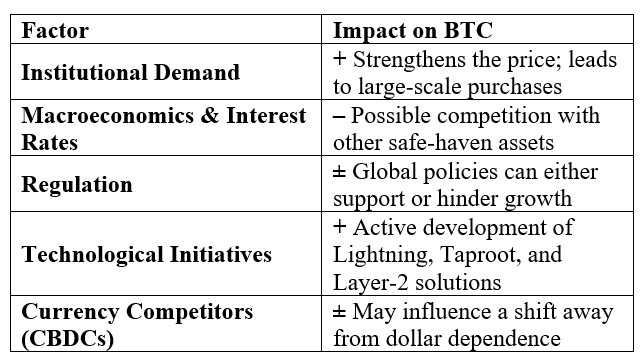Table of Content
The new all-time high: What to expect next for Bitcoin?
/>July 14, 2025: Bitcoin just made history again, crossing the $123,000 mark. The world’s first cryptocurrency has reached another all-time high, and it's no longer just crypto traders paying attention.Bitcoin breaks $123K: What happens next?
At 10:00 a.m. UTC, Bitcoin touched $123,100. By midday, the price slightly rolled back to $121,900, but the new record sent a strong signal to the entire market. Since July 10, when BTC first pushed through its May ceiling of $112,000, the coin has added about 10% in value. Bitcoin is now among the top-performing global assets in 2025 — competing not with altcoins or stocks, but with gold.
According to research from Creative Planning, BTC and gold are leading the return charts this year. It’s a rare pairing. "We’ve never seen both at the top at the same time," said strategist Charlie Bilello, whose remarks were quoted by Coindesk. In a financial world shaped by geopolitical anxiety and shifting policy, Bitcoin is no longer seen as a curiosity. It's a benchmark.
The rally is no longer a crypto-only story
The broader crypto market followed suit: total capitalization surged past $3.8 trillion — a new high. The top 100 coins gained across the board, with double- and triple-digit growth in the last seven days.
What’s different this time is how much institutional weight is behind the rally. Asset managers, sovereign wealth funds, and even governments are now openly integrating Bitcoin into financial systems. And for once, politicians aren't lagging too far behind.
This week, the U.S. Congress began what it calls “Crypto Week” — five days dedicated to reviewing key legislation on stablecoins, crypto exchange regulation, and a proposed ban on CBDCs. It’s no coincidence that Bitcoin’s price spiked just as those discussions kicked off.
From fringe asset to policy priority
Back in early March, Donald Trump — now once again President of the United States — signed an executive order to explore building a national crypto reserve. The document called Bitcoin “rare and secure,” comparing it directly to gold. Federal Reserve Chair Jerome Powell also joined the chorus, describing BTC as a “digital store of value” rather than a currency or payment method. His phrasing was deliberate: Bitcoin, he said, is no threat to the dollar. But it is becoming a serious alternative to gold.
What was once a fringe idea is now being discussed in the Oval Office, the Fed, and the halls of Congress. In short: Bitcoin’s institutional era isn’t coming. It’s already here.
Tariffs, Trump, and the new macro reality
Of course, not all of Bitcoin’s movement can be explained by crypto-native dynamics. Recent policy shifts in the U.S. — particularly the aggressive introduction of new tariffs on countries like Japan, Brazil, and South Korea — have added fresh uncertainty to global trade. Historically, that kind of uncertainty favors safe-haven assets like gold. Now, BTC seems to be filling the same role.
Interestingly, macroeconomic factors such as inflation or the Fed’s rate policy seem to be losing their grip on crypto price action. According to analysts at LondonCryptoClub, Bitcoin’s movements are increasingly shaped by liquidity flows and fiscal trends rather than short-term interest rate changes.
“The Fed used to move Bitcoin. Now it’s more about the broader money supply and dollar strength,” they noted in a July report. Bitcoin isn’t just charting its own path. It’s becoming its own macro narrative.
What could come next?
There’s no shortage of predictions. Some analysts see BTC testing $135,000 in the coming weeks. Galaxy Digital has forecast a rise to $150,000 before year-end, citing growing ETF inflows and a steady rise in institutional exposure. Trading activity also reflects the trend: long-term holders are accumulating, and exchanges are seeing record outflows.
Still, not everyone is confident this rally is bulletproof. Market watchers warn that if the U.S. Congress drags its feet on regulatory clarity — or if Trump’s trade policies backfire — it could trigger a short-term correction.
But so far, the momentum has held. Even retail investors, who had mostly sat out the last six months, are re-entering the market. Search trends for “how to buy Bitcoin” are spiking again. The psychological shift is clear: the idea of a six-figure Bitcoin no longer sounds like fantasy.
The big players are already here
While social media debates whether the bull run is sustainable, the world’s largest funds are quietly adding BTC to their portfolios. BlackRock and Fidelity now manage over $70 billion in Bitcoin through their ETFs. Saudi Arabia’s Public Investment Fund recently disclosed exposure through a Swiss-based custodian. And on-chain data hints that Apple may be experimenting with crypto treasury tools — although the company has not confirmed this.
This is a far cry from 2021, when such moves would have caused shockwaves. Today, it’s business as usual.
What to keep in mind

Bitcoin has changed the game
Bitcoin’s new all-time high is more than just a number. It’s confirmation that the rules have shifted.
Where once BTC was seen as speculative, today it's discussed in the same breath as treasuries, real estate, and commodities. It’s sitting in government reports. It’s on balance sheets. It’s in pension funds.
Whether Congress passes crypto-friendly laws this week or stalls, the bigger trend is harder to deny: Bitcoin is no longer waiting for approval. It’s setting the agenda.
The question for investors, traders, and policymakers alike is no longer “Is Bitcoin real?” The real question now is: Are you ready for it to stay?




